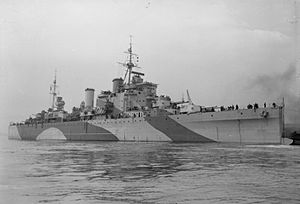HMS London (69)
 |
|
| History | |
|---|---|
|
|
|
| Name: | HMS London |
| Builder: | Portsmouth Dockyard, UK |
| Laid down: | 23 February 1926 |
| Launched: | 14 September 1927 |
| Commissioned: | 31 January 1929 |
| Identification: | Pennant number 69 |
| Fate: | Sold for scrapping, 3 January 1950. Broken up from 22 January 1950 |
| General characteristics | |
| Class and type: | County-class heavy cruiser |
| Displacement: |
|
| Length: | 633 ft (193 m) |
| Beam: | 66 ft (20 m) |
| Draught: | 21 ft (6.4 m) |
| Propulsion: |
|
| Speed: | 32 knots (59.3 km/h) |
| Range: | 9,120 nm at 12kts |
| Complement: | 784 officers and enlisted |
| Armament: |
|
| Aircraft carried: | One Supermarine Walrus, one catapult |
HMS London, pennant number C69, was a member of the second group of the County-class heavy cruisers of the Royal Navy. She and her sisters; Sussex, Shropshire, and Devonshire differed from the earlier group of Counties, (known as the Kent class), by having a smaller forward superstructure, which was positioned slightly further aft, and little armour plating. HMS London's career spanned over twenty years.
London was laid down at Portsmouth Dockyard on 23 February 1926, and later launched on 14 September 1927 and commissioned on 31 January 1929. London served with the 1st Cruiser Squadron until March 1939, and was the flagship of Admiral Max Horton during his time in command of 1st Cruisers. Her flag captain during this time was Henry Harwood. From 1936 she was the flagship of Vice-Admiral Charles Kennedy-Purvis (later Sir Charles) and on 1 September 1937 she and her sister ship Sussex made a week-long goodwill visit to Venice, mooring opposite the Doges Palace. London and her sister ship Shropshire facilitated the evacuation of thousands of civilians from Barcelona during the Spanish Civil War. From March 1939 she was under reconstruction at the Chatham Dockyard, and was much altered in appearance. Replacement of her machinery was considered, but later abandoned. She was given a new superstructure above the main deck and in many ways resembled a Crown Colony-class light cruiser. Her single 4-inch gun mounts were changed to twin mounts, and several 20mm AA guns and radar were added. In addition, she was fitted with a 3½-inch cemented armoured belt, 8 feet deep down from the main armoured deck which covered the machinery spaces. The reconstruction work was finally completed in March 1941. The refit was planned to be implemented to other ships of the County class, but due to wartime pressures no other ships were reconstructed.
...
Wikipedia
